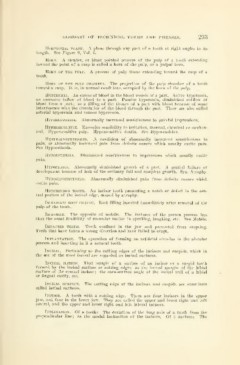Page 551 - My FlipBook
P. 551
OLOSSARV OF TECHNICAL TEKJVIS AND PHRASES. 293
IIoRizoNTAL PLANE. A plane through any part of a tooth at right angles to its
length. See Figure 9, Vol. 2.
IToBN. A slender, or blunt pointed process of the pulp of a tooth extending
toward the point of a cusp is called a horn of the pulp, or a pulpal horn.
HoEN Of THE PULP. A prooess of pulj) tissue extending toward the cusp of a
tooth.
Horn of the pulp chamber. The projection of the pulp chanibor of a tooth
toward a cusp. It is, in normal conditions, occupied by the horn of the pulp.
Hyperemia. An e.xcess of blood in the blood vessels of a part. Active hyperemia,
an excessive inflow of blood to a part. Passive hyperemia, diminished outflow of
blood from a part ; or a filling of the tissues of a part with blood because of some
interference with the circulation of the blood through the part. These are also called
arterial hyperemia and venous hyperemia.
Hyperesthesia. Abnormally increased sensitiveness to painful impressions.
Hypersensitive. Excessive sensibility to irritation, thermal, chemical or mechan-
ical. Hypersensitive pulp. Hypersensitive dentin. See Hyposensitive.
Hypersensitiveness. a condition of abnormally increased sensitiveness to
pain, or abnormally increased pain from definite causes which usually excite pain.
See Hypoesthesia.
Hypoesthesia. Diminished sensitiveness to impressions which usually excite
pain.
Hypoplasia. Abnormally diminished growth of a part. A partial failure of
development because of lack of the ordinary fuU and complete growth. Syn. Atrophy.
Hyposensitiveness. Abnormally diminished pain from definite causes which
excite pain.
Hutchinson tooth. An incisor tooth presenting a notch or defect in the cen-
tral portion of the incisal edge, caused by atrophy.
Immediate root filling. Boot filling inserted immediately after removal of the
pulp of the tooth.
Immobile. The opposite of mobile. The features of the person present less
than the usual flexibility of muscular motion in speaking, laughing, etc. See Mobile.
Impacted teeth. Teeth confined in the jaw and prevented from erupting.
Teeth that have taken a wrong direction and have failed to erupt.
Implantation. The operation of forming an artificial alveolus in the alveolar
process and inserting in it a natural tooth.
Incisal. Pertaining to the cutting edges of the incisors and cuspids, which in
the use of the word incisal are regarded as incisal surfaces.
Incisal margin. That margin of a surface of an incisor or a cuspid tooth
formed by the incisal surface or cutting edge; as the incisal margin of the labial
surface of the central incisor; the cavo-surface angle of the incisal wall of a labial
or lingual cavity, etc.
Incisal surface. The cutting edge of the incisors and cuspids are sometimes
called incisal surfaces.
Incisor. A tooth with a cutting edge. There are four incisors in the upper
jaw, and four in the lower jaw. They are called the upper and lower right and left
central, and the upper and lower right and left lateral incisors.
Inclination. Of a tooth: The deviation of the long axis of a tooth from the
perpendicular line; as the mesial inclination of the incisors. Of a surface: The


